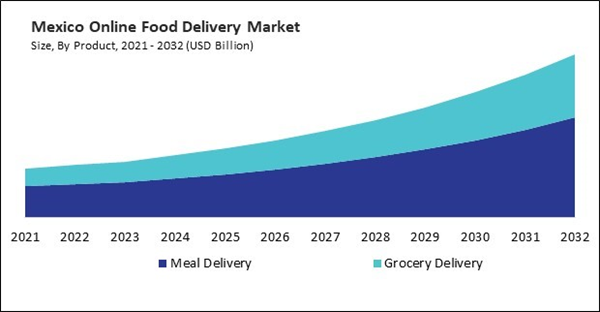The US market dominated the North America Online Food Delivery Market by country in 2024, and is expected to continue to be a dominant market till 2032; thereby, achieving a market value of $214.65 billion by 2032. The Canada market is experiencing a CAGR of 14.9% during 2025-2032. Additionally, the Mexico market is expected to exhibit a CAGR of 13% during 2025-2032.
The online food delivery market has emerged as a powerful force reshaping the food service industry, revolutionizing how consumers interact with restaurants, food providers, and digital platforms. Fueled by advancements in digital technologies, changing lifestyles, evolving consumer expectations, and the necessity for convenience, online food delivery services have not only redefined the way meals are accessed and consumed but have also spawned entirely new business models and ecosystems.
In today’s digital age, the online food delivery sector is an indispensable component of urban living, influencing everything from daily meal choices to supply chain logistics, hospitality innovation, and even food production itself. Applications of online food delivery platforms are diverse and continually expanding, reflecting the increasing digitalization of food commerce and the rising demand for flexibility. At its core, the online food delivery market facilitates the seamless connection between consumers, restaurants, and delivery partners through web portals and mobile apps.
The North American online food delivery market evolved from early website-based orders in the late 1990s and early 2000s to today’s digitally optimized app ecosystems. Innovations in mobile technology and online payment systems were pivotal in making ordering convenient and accessible. Initially, platforms were extensions of restaurant websites or aggregated menus, but with the advent of smartphones and high-speed internet in the late 2000s, dedicated delivery apps began to rise. A notable acceleration occurred with the gig economy’s emergence.
Platforms engaged independent couriers who used personal vehicles to fulfill orders, enabling rapid scaling without traditional fleet investments. Simultaneously, the concept of ghost kitchens - delivery-only kitchens without storefronts - took hold, allowing brands to optimize delivery operations and diversify food offerings at lower cost. Current consumer behavior is defined by a desire for speed, variety, and seamless app experiences. Companies invest heavily in AI-driven logistics, dynamic pricing, and subscription programs to retain customers.
With urbanization and dynamic lifestyles becoming norms, online delivery is transitioning from a convenience service to an everyday necessity. Delivery networks now include not only meals but also groceries, alcohol, pet supplies, and beyond. Meanwhile, infrastructure improvements - like micro-fulfillment centers and advanced route optimization - are enhancing throughput and service reliability. A tech-led arms race defines logistics and customer experience advancements. Platforms invest in AI-driven route optimization to minimize delivery times and idle periods. They also leverage predictive demand analytics to better align staffing and inventory in their fulfillment hubs.
Consumer-facing features like real-time order tracking, integrated payment systems, and tailored recommendations improve brand loyalty. Loyalty and subscription programs utilize these tools to deliver dynamic discounts and personalized offers, promoting user retention and frequency of use. Profitability remains elusive due to thin margins, high marketing costs, and delivery expenses. Hence, platforms scale through multi-category offerings, subscriber loyalty, and operational efficiencies.
Meanwhile, regional and niche players continue to surface in suburban or specialized segments, emphasizing local flavors or value pricing. Price-sensitive consumers sometimes revert to pick-up options, compelling platforms and chains like Domino’s to adjust strategies. Regulation, especially labor laws, and sustainability demands add complexity, pushing firms to innovate responsibly. In sum, the market is maturing, as scale, cost management, service differentiation, and regulatory compliance define sustained leadership. Hence, North America’s food delivery market is mature and tech-driven, with rising demand for convenience and personalization.
List of Key Companies Profiled
- DoorDash, Inc.
- Uber Technologies, Inc. (UberEats)
- Delivery Hero SE
- Instacart
- Zomato Limited
- Just Eat Takeaway.com
- Swiggy Limited
- HelloFresh SE
- Rappi, Inc.
- Amazon.com, Inc. (Amazon Prime Video)
Market Report Segmentation
By Type
- Platform to Consumer
- Restaurant to Consumer
By Product
- Meal Delivery
- Grocery Delivery
By Payment Method
- Online Payment
- Cash on Delivery
By Country
- US
- Canada
- Mexico
- Rest of North America
Table of Contents
Companies Mentioned
- DoorDash, Inc.
- Uber Technologies, Inc. (UberEats)
- Delivery Hero SE
- Instacart
- Zomato Limited
- Just Eat Takeaway.com
- Swiggy Limited
- HelloFresh SE
- Rappi, Inc.
- Amazon.com, Inc. (Amazon Prime Video)









